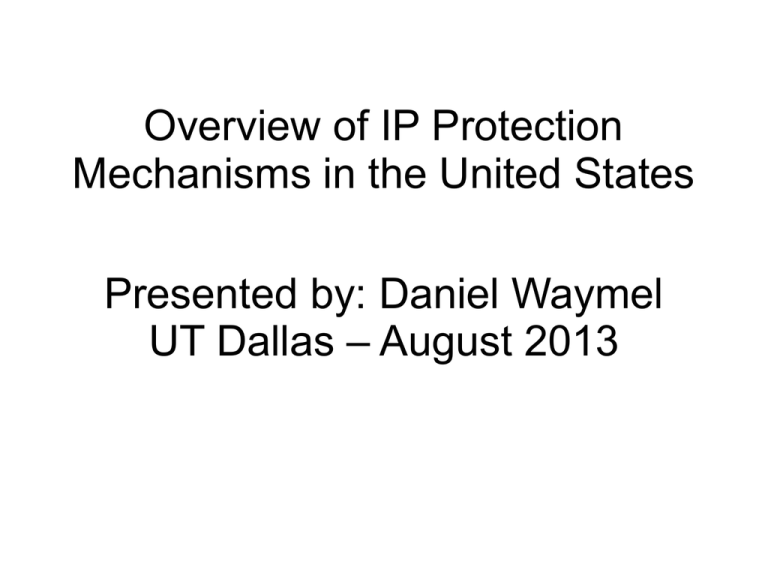Lecture9
advertisement

Overview of IP Protection Mechanisms in the United States Presented by: Daniel Waymel UT Dallas – August 2013 Outline • Patents – Overview – Types • Copyrights • Trademarks and Servicemarks • Trade Secrets Patents - Overview •A Patent is “to exclude others from making, using, offering for sale, or selling the invention throughout the United States or importing the invention into the United States" [1] •Requirements: – Invention must be: new, nonobvious, and useful[1] – Description must be adequate, clear, and in definite terms[1] Patents - Overview Steps to Acquisition: (Optional) File for a Provisional Patent Allows for “patent pending” mark and time to file for a non-provisional patent[4] Expires 12 months after submission File for a Non-Provisional Patent Patents - Overview Patents are held in the name(s) of the original inventors, but the rights may be owned by an individual or company Patents must be enforced by the patent holder without aid of the USPTO Patents - Types Utility Patents “invention [or composition or new and useful improvement] of a new and useful process, machine, manufacture, or composition of matter”[2] Typically last for 20 years after grant Design Patents “new, original, and ornamental design for an article of manufacture”[2] Typically last for 14 years after grant Patents - Types Plant Patents “new and distinct, invented or discovered asexually reproduced plant including cultivated sports, mutants, hybrids, and newly found seedlings, other than a tuber propagated plant or a plant found in an uncultivated state”[2] Typically last for 20 years after grant Reissue Patents – “correct an error in an already issued utility, design, or plant patent”[2] Patents - Types Defensive Publication Issues in place of a normal patent this “offers limited protection, defensive in nature, to prevent others from patenting an invention, design, or plant”[2] Statutory Invention Registration Introduced in 1985-1986 to replace the Defensive Publication and offers similar protection Copyrights “A form of protection provided to the authors of ―original works of authorship‖ including literary, dramatic, musical, artistic, and certain other intellectual works, both published and unpublished”[4] Grants “the owner of copyright the exclusive right to reproduce the copyrighted work, to prepare derivative works, to distribute copies or phonorecords of the copyrighted work, to perform the copyrighted work publicly, or to display the copyrighted work publicly”[4] Copyrights For works created on or after January 1, 1978, they are automatically protected for the lifetime of the creator plus an additional 70 years. For joint works, the duration is through 70 years after the last surviving creator's death.[5] For commissioned works, the duration is either “95 years from publication or 120 years from creation, whichever is shorter”[5] Copyrights No registration or application is required for copyright protection, protection is automatic from the time of creation. – Registration is encouraged for ease of enforcing copyrights however. Trademarks and Servicemarks A trademark is a word, name, symbol, or device that is used in trade with goods to indicate the source of the goods and to distinguish them from the goods of others.[3] A servicemark is the same as a trademark except that it identifies and distinguishes the source of a service rather than a product.[3] Trademarks and Servicemarks Registration with the federal government is not required but is encouraged as it grants several benefits:[3] Public notice of the holder's claim to the trademark Presumption of ownership nationwide Exclusive rights to use the trademark in conjunction with the good/services listed in the registration Trade Secrets Protects any IP Lasts until the information is divulged No formal steps to obtain this protection – don't tell Any company or individual can implement this protection No enforcement of this protection (excepting laws governing actions that might be taken to obtain another's trade secret, such as theft) References [1] http://www.uspto.gov/inventors/patents.jsp#heading-2 [2] http://www.uspto.gov/web/offices/ac/ido/oeip/taf/patdesc.h tm [3] http://www.uspto.gov/trademarks/basics/definitions.jsp [4] http://www.uspto.gov/patents/resources/general_info_con cerning_patents.pdf [5] http://www.copyright.gov/circs/circ01.pdf [6] http://www.uspto.gov/trademarks/index.jsp Contact Daniel Waymel daniel.waymel@utdallas.edu http://www.utdallas.edu/~dxw113730


